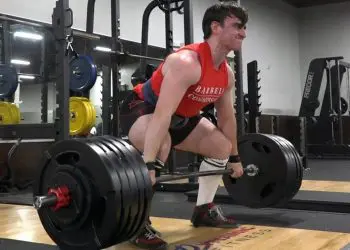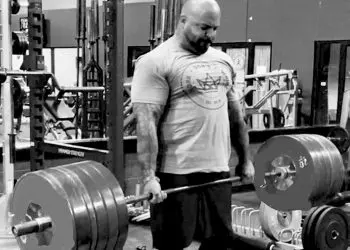Strength has always been the standard by which “manliness” is measured. And a good powerlifting program will no doubt take your results to another planet!
Now, powerlifting is a lot different than the typical weight training routines you may be used too (Unless you’re a powerlifter). And there’s a lot more involved when it comes to preparation, form, training style, etc.
Powerlifting involves training with heavier loads more often and we’ll give you some information about how to approach it with an intelligent strategy which will yield results and ensure you avoid injury.
Powerlifting Basics
Ok, so there are usually three exercises a powerlifter focuses on since these are the lifts in competition.
- Squat
- Deadlift
- Bench press
Now, gaining strength requires a lot of low rep training to really overload the nervous system.
But some powerlifters also train with higher reps and isolation exercises to experience the hypertrophy benefits of a higher volume muscle-building program. However, low reps do still build plenty of muscle along with the strength increases.
Level Up Your Fitness: Join our 💪 strong community in Fitness Volt Newsletter. Get daily inspiration, expert-backed workouts, nutrition tips, the latest in strength sports, and the support you need to reach your goals. Subscribe for free!
But building pure strength is obviously the main focus, whereas aesthetics are secondary, if at all a concern.
If you want to get stronger for a specific sport then you’ll need to train accordingly. But, we’re going to focus on the basic three movements. And if you want to get better at the squat, deadlift and bench press, then the thing you must do more of is, yes, you guessed it… squat, deadlift and bench press.
Now, you can’t always train heavy and you, therefore, taking a week where you give your joints a break is important. So, a Deload week is important where you train at around 40-50% of your 1-RM.
Constant heavy training with really low reps will cause maladaptation and overtraining symptoms. But, training with lighter loads every now and then can prevent this. (1)
Fast twitch fibers
Powerlifting activated fast twitch (Type II) fibers which are responsible for explosive strength movements. They burn out quicker than the slow twitch fibers but you want to be quick when powerlifting. (2)
This allows you to maximally recruit the type II fibers and perform the lift with full strength and power.
Progression
The point of powerlifting is to keep improving your lifts to perform better each time. And progression is only achieved through progressive overload. When we lift weights, our bodies compensate by getting stronger and building muscle.
But, plateaus happen when we become stagnant with the training stimulus. And, we must try to switch up our routines and give out bodies the rest it needs.
That’s why we’ve designed a progressive program with varying rep ranges, and weight loads (% of 1-RM).
Training based on the level of training experience
If you’re a beginner, then you’ll need to train more frequently at first. This is to get your nervous system and joints familiar with the mechanics of each movement. A beginner needs to focus on getting the lifts down as quickly as possible.
But, of course, the weight loads will not be as high.
Now, if you’re an intermediate lifter who’s trained for more than 6 months to a year, training should be less frequent larger resistance loads.
The more advanced you are, the more you can push your body since it has adapted to serious poundages. And volume won’t cause you to overtrain as easily as someone who’s not as experienced.
But, one study showed high and low-frequency training to yield similar results in strength and muscle hypertrophy. So, quality is always better than quantity and rest days are important for joints and your nervous system. (3)
Form
Never compromise good form for a lift. This is dangerous and will allow other body parts to take over a lift which is bad for muscle development and lifting mechanics. However, it is common for other muscles to assist but you must learn how to utilize them effectively.
Cheating and using a little controlled momentum are two different things!
Progressive 10-Week Powerlifting Program
Here you’ll find a powerlifting program suitable for all experience levels. But the only differences will be the frequency (Days you train per week), and amount of weight used.
The program includes periodization for the 10 weeks and will allow you to progress. Increasing resistance in increments aggressively is important for making significant improvements.
You’ll use the same exercises and here’s some information about the warm-up, set/rep ranges and rest time in between sets.
Before attempting your working sets, make sure to warm-up with at least two progressive sets of 30 to 50-60% of your (1-RM).
Sets/Reps
Most of us would agree that 5×5 is perfect for most people implementing a strength training routine. And why is that?
Well, beginner, intermediate, and advanced lifters can all follow this regime safely and it’s effective. Stronglifts 5×5 is a popular program for a reason because it’s simple and you’ll build a butt load of strength.
Muscle overload is ideal in this range to build power and explosiveness.
But, this isn’t the only set/rep range we’ll focus on. Low reps (5 or less) are the key to building massive strength and so we’ll include 2×2, 3×3, and 4×4 set/rep ranges along with the 5×5 training protocol.
Set/reps by each week
Level Up Your Fitness: Join our 💪 strong community in Fitness Volt Newsletter. Get daily inspiration, expert-backed workouts, nutrition tips, the latest in strength sports, and the support you need to reach your goals. Subscribe for free!
- Week 1: 5 x 5-6 (75% of 1-RM)
- Week 2: 4 x 4 (70% of 1-RM)
- Week 3: 3 x 3 (80% of 1-RM)
- Week 4: Deload (50% of 1-RM)
- Week 5: 4 x 4 (80% of 1-RM)
- Week 6: 3 x 3 (85% of 1-RM)
- Week 7: 4 x 4 (55% of 1-RM)
- Week 8: Deload (50% of 1-RM)
- Week 9: 4 x 3 (75% of 1-RM)
- Week 10: 3 x 2 (90% OF 1-RM)
This is a basic program to allow you to progress quickly. But, when you’re not doing this program, feel free to use varying rep ranges if you feel you can handle it. For example, 7 sets x 3 reps at a lower percentage (50-60%) of your 1-RM can be very effective.
But, if you’re training for competition, the provided program is ideal.
Day 1 – Lower Body (Squat Focus)
Isn’t leg training just the most fun workout day of the week? Ok, we get… but it still has to get done. It’s so incredibly important to build a solid base and that means your wheels need a lot of attention.
Now, each set will be relatively low in reps and since we’re training for strength and not muscle hypertrophy, you can rest a bit longer to recuperate before your next set. This will prevent overtraining and allow you to lift at a high level of intensity.
If you’re training at around 80% of your 1RM (one-rep max), a 3-minute rest should be sufficient. But, if you’re training higher than 80%, 5 minutes is more necessary to come back with equal intensity…
Back Squat
- 5 sets x 5-6 reps (4-5 minute rest)
Rack pull
- 5 sets x 5-6 reps (4-5 minute rest)
Front Squat
- 5 sets x 5-6 reps (4-5 minute rest)
Day 2 – Rest
Day 3 – Upper Body (Bench Press)
The bench press will be the main focus here with a few variations
Barbell bench press
- 5 x 5-6 reps (4-5 minute rest)
Incline Dumbbell bench press
- 5 x 5-6 reps (4-5 minute rest)
Neutral-grip dumbbell bench press
- 4 x 5-6 reps (4-5 minute rest)
Straight bar tricep pushdowns
- 3 x 10-15 reps (3-minute rest)
Day 4 – Rest
Day 5 – Mobility Training
Work on your mobility and flexibility to ensure you’re always prepared to train at optimal efficiency.
Day 6 – Rest
Day 7 – Lower Body (Deadlift Focus)
Deadlift days should be separate from squat days since two compound movements in a workout is very taxing. Deadlifts also work the entire posterior chain and you can generally go very heavy.
So, you won’t be able to do a lot on deadlift day!
Barbell deadlift
- 5 x 5-6 reps (5-minute rest)
Bent-Over Barbell Row
- 5 x 5-6 reps (3-minute rest)
Other Best Powerlifting Programs
Nutrition and Recovery
Protein repairs muscle, but carbs and fats supply energy. So, make sure to get plenty of them. But calories in general play a big role in overall, progressive strength gains.
And being adequately hydrated is also crucial for maximizing strength, as even a little dehydration (3-4% of body mass) can drop strength levels a few percents. (4, 5, 6, 7)
Also, the body repairs itself best we get quality sleep so make sure to get your 7-9 hours every night to recover and come back even stronger.
According to research, lack of sleep effects performance unless you seek intervention through caffeine and other energy-promoting substances. (8)
Who Can Do This Program?
If you have been training for 6 months to a year, then you can try this program. Otherwise, you could injure yourself, although, powerlifting training is proven safer than sport-type training.
So, a beginner powerlifter program should actually not mean a “beginner” to strength training.
Concluding Thoughts
Powerlifting is rewarding and the strength gains are a big plus!
But, everyone has to start somewhere and this powerlifting program will allow you to progress rather quickly. 10 weeks is a short amount of time to really make drastic changes and that’s why this program is intense.
But, regardless of your training experience, you can be impressive if you remain consistent with your training and nutrition. So, prepare yourself to make some big leaps in strength!









Deload week: what are the sets and reps?
Hi, I am a 72yr old man that tried your 10 week power lifting routine. I have several years of lifting experience. However, this was my first try at a strict powerlifting program. I weigh 230lbs. my starting 1R max. was as follows: squat: 320lbs. bench:240lbs. deadlift:380lbs.Ifollowed the program as shown on your web site. The only changes I made was in the 10th week. The 3×2 @ 90% lifts I did was as follows: 1×2-90%, 1×2-95%, 1×2-98%. Yesterday I went for new PR and 1RM in all 3 lifts trying to mimic and copy a meet format. I spent about 4hrs total figuring warm up sets, general stretching and mobility work prior to the start of each lift . then following the 3 lift attempt format all 3 lifts. I hit all nine lifts. That felt great! Final totals for 3rd lifts: squat:355lbs, bench:255lbs, dead lift: 395lbs.=1005lbs.
I know the numbers are not great, but the gains and new PR’s feel great. You know what you are doing.
Dave
Thank you David!
Is it okay to just do the content of the above class schedule?
No need to do other parts?
Deadlift on the seventh day of the first week will be directly followed by the squat on the first day of the second week?
Hi! My name is Alex and i want to follow this program. I found myself to be advanced in powerlifting and I want to improve and compete for powerlifting. My answer is, after these 10 weeks, how can you look at your progression? I should test my 1 RM every 10 weeks? How can I know, ok, now it’s the moment to add some more weights?
Using Deadlifts as an example, my 1RM in Deadlift is 180kg. Do I base my % of 1RM each week on that weight or do I calculate each week if my 1RM has went up via those online 1RM max calculators to get a true reflection on what my 1RM is when coming into a new week and needing to calculate a % of my 1RM? Or do I try a max effort after week 10 to see if my Deadlift has increased? Also with the varying %’s of 1RM each week i.e. week 1 being 75% and week 2 being 70% is that still conducive to building strength with the weight in week 2 being 5%?
Great question! When following a powerlifting program that is based on a percentage of your 1RM, it’s important to use an accurate estimate of your current 1RM. If your 1RM has recently changed, you should recalculate your percentages to reflect your new strength level.
Using an online 1RM calculator (https://fitnessvolt.com/one-rep-max-calculator/ or https://fitnessvolt.com/deadlift-calculator/) can be a useful tool for **Estimating your 1RM, but keep in mind that these calculators are not always 100% accurate. The best way to determine your true 1RM is to test it through a max effort lift, as you mentioned.
As for the varying percentages of 1RM each week, it’s important to understand that these percentages are designed to challenge your body in different ways throughout the program. Week 1’s 75% may feel lighter than week 2’s 70%, but the lower percentage is intended to help you recover and prepare for the heavier weights in the coming weeks.
Overall, consistency and accurate tracking of your progress are key to building strength through a powerlifting program. Make sure to track your lifts and adjust your percentages accordingly to ensure that you are consistently challenging yourself and making progress towards your goals.
Many thanks for the reply Tom. I’m currently just finished week 2. Again, using Deadlifts as an example. Week 1 Deadlifts were 135kg 5 x 5 and week 2 was 125kg 4 x 4. I found the 2nd week Deadlift session incredibly easy with much more strength off the floor and I’m not sure if a) it’s due to getting stronger or b) whether my 1RM has changed since week 1 meaning my calculations for week 2 were off and should have been heavier. If I need to adjust my % weight each week in relation to a possible increase in strength does that not mean having to do a max effort EVERY week which might be taxing on the body? If the first couple of sets feel really easy should I go up in weight for the next set until the last couple of reps feel tough?